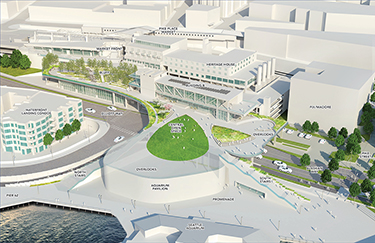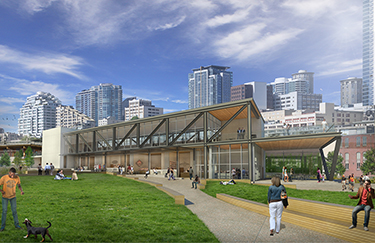|
Subscribe / Renew |
|
|
Contact Us |
|
| ► Subscribe to our Free Weekly Newsletter | |
| home | Welcome, sign in or click here to subscribe. | login |
Architecture & Engineering
| |

|
|
Design Perspectives By Clair Enlow |
August 10, 2016
Design Perspectives: The future looks bright for Seattle's waterfront
Special to the Journal
Seattle's central waterfront redevelopment is due for some sunshine, and this summer its future is looking bright. It's about time.
After Bertha quickly stalled, forcing delays in the demolition of the Alaskan Way Viaduct by four years, the tunneling machine is now crunching away deep underground, building a tube to take state Route 99 traffic under the city.
The din of wheels on the viaduct continues unabated while Bertha digs, but her tunneling success means now we can have greater confidence about the scheduled demolition of the elevated freeway in 2019.
The defeat of Initiative 123 last week was a stake through the heart of Park My Viaduct, which would have had the city put a park atop a piece of the old elevated roadway. It was an idea that never passed the first test of practical reality and should have died long ago, but the ballot measure continued to haunt waterfront redevelopment plans. Luckily voters decided they would not attempt to redirect a waterfront design process that has been in place for a decade.
In the meantime, the Downtown Seattle Association has partnered with Friends of Waterfront Seattle and the city to activate open spaces in the city, and make them more inviting. Old attitudes die hard, including the expectation that urban parks are either tourist spectacles or spare rooms for the homeless. People who live and work in the city are now flooding into our urban plazas. The DSA is also now positioned to help broker the Local Improvement District, a local tax that will be a key part of financing the waterfront redevelopment. Growing satisfaction with existing parks will help.
Making connections
In the meantime, the bluff just below Pike Place Market is a construction site. The elevated roadway still standing along the bluff has not stopped the market from building west, securing its post-viaduct destiny as a jumping off place for the urban shore.
Designed by The Miller Hull Partnership, MarketFront (as the extension of Pike Place Market is called) is a tight-knit combination of retail and mixed-use structures, open spaces and pedestrian pathways between the market and edge of the viaduct. It's being built just as if the viaduct were not there.
When MarketFront opens next year, the old Joe Desimone Bridge — which has long been a bridge to nowhere on the west edge of the market over Western Avenue — will be a grand entry to the future waterfront. It will spill out onto the roof of a large structure with many parts, including hundreds of parking stalls, retail space and senior housing. The project includes 30,000 square feet of open space, much of which will sit high above the current viaduct, overlooking Elliott Bay, at the level of the bridge deck.
When the aerial highway comes down, MarketFront will join seamlessly with the Overlook Walk, an elevated structure with pathways and scenic overlooks jumping the bluff between Pike Place Market and Alaskan Way. Miller Hull has worked hand in hand with James Corner Field Operations, the designer of the Overlook Walk, to meld the two projects.
So the transformation of Seattle's central waterfront marches on with plans for that centerpiece of civic infrastructure, the Overlook Walk. And it is looking better all the time.
Last month design lead Tatiana Choulika of JCFO showed new images of Overlook Walk to the Seattle Design Commission. They reflect responses to the commission's concerns about making the main path to Alaskan Way easy to find.
After descending from MarketFront, the pathway of the Overlook Walk lands in a large plaza with sweeping views over Alaskan Way. Then the grand path splits into two grand stairways — one that heads south toward the ferry terminal and one that takes a northwesterly tack toward Pier 62.
Between the two stairways at the foot is Building C, which must be structurally adjoined to the Overlook Walk and also structurally independent. If that seems like a conundrum, it is. Although Building C will be integrated with the Overlook Walk, it's also an extension of the Seattle Aquarium, containing water and sea life. As of last month, design for the Overlook Walk and Building C, also known as the Ocean Pavilion, was not synchronized enough to marry the two structures. Some JCFO images show a phase of Overlook Walk that is almost literally cut off at the base, with underlying structure exposed, to be built before the aquarium part of the project.
Seattle Aquarium, which has been working with EHDD of San Francisco and exhibit designer Thinc of New York on conceptual design, now has hired Chris Rogers of Point 32 as a consultant on the development. Rogers has consulted on Seattle Art Museum's Olympic Sculpture Park and the Bullitt Center.
Colman Dock
Meanwhile on the water's edge two long-planned shoreline projects, Colman Dock and Pier 62, will go ahead with construction before the viaduct comes down.
JCFO is showing a scaled-back version of the future of Pier 62 (which is joined with the historic Pier 63). Gone is the swimming pool barge that was in earlier drawings, and there is no amphitheater-like superstructure on the deck. Instead, the pier will be restored as a wide-open over-water event space where temporary installations and seating can be moved around. Construction should start in the fall of 2017 and last about two years.
Redevelopment of Colman Dock and the ferry terminal has reached the 60 percent design stage. Images shown last week by architects from NBBJ and SRG Partnership reveal a new passenger deck with an open plaza spanning two structures, all adjoining a re-built Marion Street pedestrian bridge. The new steel structures, with high, wood-finished ceilings, will make room for revised car queuing below and a rebuilt passenger-only terminal. Construction will begin in mid-2017, continuing into early 2023.
Clair Enlow can be reached by e-mail at clair@clairenlow.com.
Previous columns:
- Design Perspectives: Occidental Park getting a great new neighbor, 07-27-2016
- Design Perspectives: Can we put a lid over our urban freeways?, 06-29-2016
- Design Perspectives -- District energy: Lots of talk, but still little action, 06-08-2016
- Design Perspectives: New paths and parks make Yesler Terrace shine, 05-04-2016
- Design Perspectives: Cities improving streets with paint, and political will, 04-06-2016
- Design Perspectives -- WSCC expansion: So what's inside the box?, 03-09-2016
- Design Perspectives: UW eyes 8 million square feet of new buildings, 02-17-2016
- AIA winners manage to surprise and inspire, 11-18-2015




